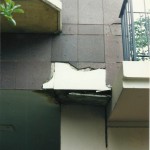 HORIZONS
HORIZONS
Kimball J. Beasley, PE, F.ASCE
Building façades are often constructed with materials of variable strength that are constantly exposed to weather and attached with hundreds or thousands of concealed connections that cannot be easily inspected or maintained. These materials and connections, which may have been installed with minimal supervision due to difficult access, are often suspended over busy sidewalks with the expectation they will last forever—or at least for the building’s economic life.
The long-term performance of building façades can be unpredictable. However, some have features or properties that tend to make them susceptible to failure. These factors can be identified and evaluated to determine the overall risk of façade failure.
Contemporary building façades often have internal supports and weather barriers that can be damaged or can deteriorate without any outwardly visible signs. This can lead to dramatic failures, such as sudden collapse of the façade, or more subtle failures, such as cracking or water leakage.
Façade failures are almost always costly and can sometimes be dangerous. Building designers and owners are seldom aware of the risk until a failure occurs. While the types of problems that could develop over the life of any building are almost limitless, recognizing vulnerable façade characteristics can help predict the likelihood of future failures.
During the design of new buildings or the evaluation of existing buildings, the relative risk of façade failures can be assessed by ‘grading’ various risk factors using a system developed by this author. The nine façade failure risk factors listed below describe properties predictive of the greatest risk or consequences of failure.
1. Failure consequence
This category covers risk to pedestrians—for example, building façades situated directly above congested urban sidewalks.
2. Inadequate support redundancy
This factor deals with the risk of disproportionate failure progression—for example, an inability to redistribute loads after the loss of one or more supports.
3. Low tension tolerance
The inability of façade materials or supports to resist tensile forces—such as tensile or flexural stresses imposed at mortar bond (adhesion) locations—is included in this category.
4. Poor reliability
Façade performance uncertainty (e.g. anchors with variable strength or façades of unproven or incompatible materials) fall under this factor.
5. Inadequate durability
Inadequate durability could stem from insufficient resilience, toughness, or robustness—for example, brittle, corrodible, or degradable façade materials or supports.

6. Poor constructability
Some components are difficult to install without error. For example, certain façade support systems have unnecessarily complex installation details or insufficient allowance for construction tolerances.
7. Poor maintainability
The need for frequent, difficult, and/or costly maintenance is another failure factor (e.g. repair or replacement of internal weather seals that require façade removal).
8. Inadequate water management
Another failure factor is an inability to control rainwater infiltration—for example, improperly configured or missing through-wall flashings, obstructed drainage cavities, or reliance solely on surface seals.
9. Failure without warning signs
The final category involves a lack of visible symptoms. This would be façade materials or anchors unlikely to exhibit cracking or displacement before failing.
While an investigation is needed to confirm concealed conditions, and to determine the nature and extent of deficiencies present, the nine façade failure risk factors listed in this article can be collectively interpreted to assess the overall risk. This assessment can help:
- designers anticipate and avoid future failures;
- building owners determine the need for remedial action for existing façades to reduce the risk of failure; and
- building purchasers and insurance underwriters make informed decisions.
Kimball J. Beasley, PE, F.ASCE, is a structural engineer and senior principal with the Princeton, New Jersey office of Wiss, Janney, Elstner Associates (WJE). Over his 40-year year career, he has investigation more than 600 building facade failures. Beasley is a fellow of the American Society of Civil Engineers (ASCE) and registered as a professional engineer in 10 states. He has a bachelor of science in structural and material engineering from the University of Illinois?Chicago, and a masters of business administration from Pace University, New York. Beasley can be contacted via e-mail at kbeasley@wje.com.




